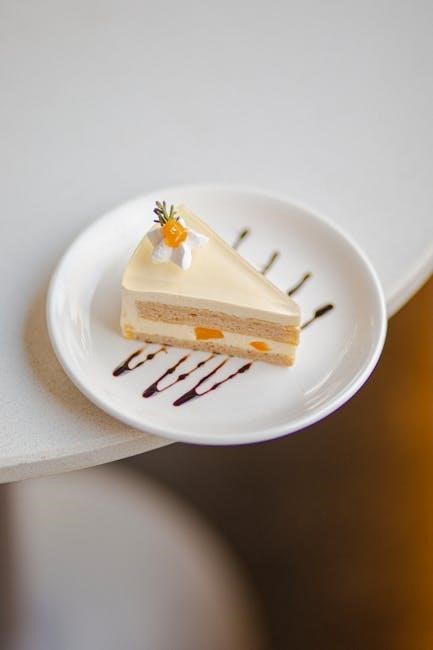Understanding Cake Sizes and Servings
Understanding cake sizes and servings is crucial for planning events. A 6-inch round cake typically serves 8-12 people‚ while a 6-inch square cake serves 9-12. Cake height and slice size significantly impact servings‚ with taller cakes offering more slices if cut thinner. Standard serving sizes vary between party and wedding portions‚ ensuring enough for everyone.

Round Cakes: Standard Servings by Diameter
Round cakes offer consistent serving sizes based on their diameter. A 6-inch round cake typically serves 8-12 people‚ while an 8-inch serves 12-16. Larger diameters‚ like 10-inch‚ yield 16-20 servings‚ and a 12-inch can serve up to 24. These sizes are standard for both party and wedding portions‚ ensuring enough for everyone. Serving sizes may vary depending on how the cake is cut‚ but diameter remains the primary factor in determining servings. This guide helps in selecting the right cake size for any event‚ ensuring every guest is accommodated with a generous portion.
Square Cakes: Servings Based on Size
Square cakes provide versatile serving options‚ with servings varying by size. A 6-inch square cake typically serves 9-12 people‚ while an 8-inch serves 12-15. Larger squares‚ such as 10-inch‚ yield 15-20 servings‚ and 12-inch squares can accommodate up to 24. These sizes are ideal for both casual gatherings and formal events. The square shape allows for clean‚ even slices‚ making it easier to estimate portions. By considering the size of the square cake‚ hosts can ensure ample servings without waste‚ making them a practical choice for various celebrations and occasions‚ ensuring every guest enjoys a fair share.
Tiered Cakes: Calculating Total Servings
Tiered cakes offer a stunning presentation while serving large groups. To calculate total servings‚ sum the servings of each tier. For example‚ a 4-inch tier serves 8-10 people‚ a 6-inch serves 12-15‚ and an 8-inch serves 20-24. Larger tiers‚ like 10-inch‚ yield 25-30 servings. The overall design and height can affect slicing efficiency. Using a serving chart ensures accurate planning. By calculating each tier’s contributions‚ you can create a cake that meets your event’s needs‚ whether it’s a grand wedding or a festive celebration.
Party vs. Wedding Servings: What’s the Difference?
Party servings are larger (1.5×2 inches) for casual events‚ while wedding servings are smaller (1×2 inches) for formal gatherings‚ ensuring elegant portion control.
Party Servings: Larger Portions for Casual Events
Party servings are typically larger‚ with slices measuring 1.5 inches by 2 inches‚ making them more generous for casual gatherings. This size is ideal for events where guests may have bigger appetites or want hearty portions. For example‚ a 6-inch round cake can serve 8-12 people with party-sized slices‚ while an 8-inch round cake serves 12-16. Square cakes‚ such as a 6-inch square‚ yield 9-12 servings. The larger portion size ensures satisfaction in relaxed settings like birthdays or social parties. This approach contrasts with wedding servings‚ which are smaller and more formal. The key is balancing guest numbers with portion preferences for a seamless event.
Wedding Servings: Smaller‚ More Formal Portions
Wedding servings are typically smaller and more formal‚ with slices measuring approximately 1 inch by 2 inches. This size is ideal for formal events where guests may prefer smaller‚ more elegant portions. For example‚ a 6-inch round cake can serve 12-16 people with wedding-sized slices‚ while an 8-inch round cake serves 16-20. Square cakes‚ such as a 6-inch square‚ yield 12-15 servings‚ and an 8-inch square serves 16-20. The smaller portion size aligns with the sophistication of weddings‚ ensuring a refined presentation while accommodating guest expectations for a tasteful treat. This approach balances aesthetics and flavor‚ making it perfect for formal celebrations.

Factors Affecting Cake Servings
Cake height‚ slice size‚ and shape influence servings. Taller cakes yield more slices‚ while larger portions reduce total servings. Shape affects cutting efficiency‚ impacting overall yield.
Height of the Cake: How it Impacts Servings
Cake height significantly affects the number of servings. A taller cake‚ typically 3-6 inches high‚ can yield more slices if cut thinly. Standard serving charts often assume a cake height of 4 inches. However‚ slicing a taller cake into thinner portions increases the serving count. For example‚ a 6-inch round cake that is 6 inches tall can serve up to 24 people when sliced into 1-inch thick pieces. Conversely‚ a shorter cake may serve fewer people due to larger slice sizes. Adjusting cake height allows for better portion control‚ ensuring enough for all guests while maintaining visual appeal.
Slice Size: Standard vs. Custom Cuts
Slice size plays a key role in determining cake servings. Standard slices are typically 1.5 inches wide and 2 inches tall for parties‚ while wedding slices are smaller‚ around 1 inch wide and 2 inches tall. Custom cuts can maximize servings by slicing thinner or adjusting heights. For example‚ cutting slices horizontally doubles portions. Using a serving guide helps maintain consistency‚ but custom cuts allow flexibility based on event needs and guest preferences. Balancing slice size with cake height ensures efficient serving without compromising presentation or taste‚ making it easier to accommodate diverse appetites and event styles effectively. Proper slicing techniques are essential for accurate portioning.
Calculating the right cake size involves determining guest count‚ desired servings‚ and slice preferences. Use serving guides to match cake size to event needs efficiently‚ ensuring everyone is served. Determining the number of guests is the first step in calculating the right cake size. This ensures enough servings for everyone without excess. Consider RSVPs and event type to estimate accurately‚ using serving guides to plan effectively. Always account for potential leftovers or varied appetites to avoid shortages. Understanding guest count helps in choosing the correct cake size‚ ensuring all attendees are satisfied. Accurate numbers are essential for a successful event‚ making this step crucial in the planning process. Using online tools can also help refine estimates for precise calculations. This step is foundational for all subsequent cake planning decisions. Choosing the right cake size involves considering guest count‚ serving preferences‚ and event type. For casual gatherings‚ larger slices are common‚ while weddings often require smaller‚ more formal portions. Round cakes‚ like 6-inch (serves 8-12) or 8-inch (serves 12-16)‚ are popular for smaller events. Square cakes‚ such as 6-inch (serves 9-12)‚ offer similar flexibility. For larger events‚ 10-inch or 12-inch cakes are ideal‚ serving 24-36 guests. Tiered cakes provide versatility for varying guest numbers. Use serving charts to match cake size to your event needs‚ ensuring everyone enjoys a portion. This step ensures your cake fits both the occasion and your guests’ expectations perfectly. Planning ahead guarantees success. Adjusting for leftovers or larger appetites ensures no one leaves disappointed. Increase cake size by 1-2 inches for extra portions. A 10-inch cake serves 24-36‚ while a 12-inch serves 36-48. Consider taller cakes‚ as they yield more slices with thinner cuts‚ boosting servings by 20-30%. For hearty eaters‚ opt for larger slices or add a sheet cake. This approach ensures ample dessert for all‚ accommodating both leftovers and bigger appetites without compromising presentation or flavor. Planning for extras guarantees everyone enjoys the celebration with a satisfying slice. It’s a thoughtful way to make your event even more memorable. Cake serving charts and guides provide detailed information to determine the right cake size. Use standard charts‚ visual guides‚ or online calculators to ensure accurate servings. Standard cake serving charts are essential tools for determining the right cake size. These charts typically differentiate between round and square cakes‚ providing serving numbers based on diameter or side length. For example‚ a 6-inch round cake serves 8-12 people‚ while an 8-inch round cake serves 15-20. Square cakes‚ such as a 6-inch square‚ serve 9-12 individuals. The charts often include adjustments for cake height‚ as taller cakes can yield more servings if sliced thinly. These guides are based on standard portion sizes‚ ensuring accurate planning for events. They are widely available online and in baking resources‚ making them indispensable for bakers and event planners alike. Visual guides for portion planning are invaluable for understanding cake sizes and servings. These guides often include images or diagrams that illustrate how to cut cakes into standard or custom slices. For example‚ a round cake might show markings for 8‚ 12‚ or 16 slices‚ while a square cake could demonstrate how to achieve 9‚ 12‚ or 16 portions. Many guides also use tables or charts to compare cake diameters‚ heights‚ and serving capacities‚ making it easier to visualize the number of guests each size can accommodate. These tools help ensure that every event has the right amount of cake‚ avoiding waste or shortages. Online tools for custom cake calculations simplify planning by providing precise serving estimates. These tools allow users to input cake dimensions‚ shape‚ and desired portion sizes to calculate servings. Some tools feature interactive sliders to adjust cake diameter and height‚ while others offer dropdown menus for selecting round or square cakes. Advanced platforms may even account for tiered cakes‚ summing servings from multiple layers. Many tools also provide visual representations‚ such as diagrams showing how slices can be cut for maximum yield. These resources are invaluable for bakers and event planners‚ ensuring accurate portion planning and avoiding shortages or leftovers at gatherings. Use a serrated knife for clean cuts and even slices. Ensure consistent slice size by measuring portions. Consider guest appetites and event type when planning servings. To maximize cake servings‚ use a serrated knife for clean‚ even cuts. Start by cutting the cake into uniform slices‚ ensuring each slice is consistent in size. For round cakes‚ cut in a radial pattern from the center outward. For square cakes‚ cut in a grid pattern‚ dividing the cake into equal rows and columns. Consider using a cake stand or turntable for easier access. Always cut on a stable surface and use a serving spatula to remove slices. For taller cakes‚ slice horizontally to create additional layers‚ doubling the number of servings. This method ensures every guest gets an equal portion. When planning cake servings‚ avoid common mistakes like overestimating the number of slices or using uneven cuts. Cutting slices too thick reduces the total servings‚ while overly thin slices may not satisfy guests. Not accounting for cake height or shape can lead to miscalculations. Using a dull knife can cause uneven portions and waste. Forgetting to consider the serving style (party vs. wedding portions) may result in insufficient cake. Always measure slices consistently and use a cake serving chart as a guide to ensure accuracy. Proper planning and precise cutting techniques help prevent these errors and ensure everyone enjoys their fair share.
Calculating the Right Cake Size
Determining the Number of Guests
Choosing the Right Cake Size for Your Event
Adjusting for Leftovers or Larger Appetites

Using Cake Serving Charts and Guides
Standard Cake Serving Charts
Visual Guides for Portion Planning
Online Tools for Custom Cake Calculations
Additional Tips for Accurate Serving
How to Cut Cake for Maximum Servings
Common Mistakes to Avoid


